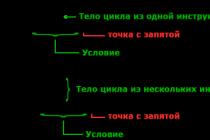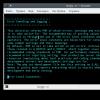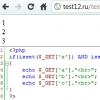On January 24, 2013, an army of radio amateurs listening to shortwave broadcast, burning with excitement and setting the volume to the maximum, caught a clear signal in Russian: "Team 135 Announced". "Something is happening!" - the fans decided, because the order was transmitted by the "most mysterious in the world" Russian radio station, known as UVB-76, and this happened for the first time in 40 years!
Buzz, ciphers and "Swan Lake"
Prior to this, the station became famous as a "buzzer" - because of the characteristic sounds heard on its frequency of 4625 kHz from about the late 1970s. you can listen to the earliest recording of "buzz", made in 1982.
Judging by what the radio amateurs managed to trace, the buzzer occasionally (used to be once every few years) turned off, and the Russian voice read out strange ciphers. This one, for example, was broadcast a few hours before Christmas 1997:
“I am UVB-76, I am UVB-76. 180 08 BROMAL 72 27 99 14. Boris, Roman, Olga, Mikhail, Anna, Larisa. 7 2 2 7 9 9 1 4".
It is interesting that the mysterious station did not stop working after the collapse of the USSR, but, on the contrary, became more active. Signal catchers noticed that since the 2000s, voice radiograms began to be broadcast on it more and more often. And in 2010, strange transmissions on this frequency could be intercepted every month.
At the forums of radio amateurs, including those abroad, exciting discussions unfolded. On 4chan, for example (the same site that was at the center of a huge scandal with the leak of "naked" photos of celebrities in 2014), the station UVB-76 was discussed in the section devoted to "paranormal phenomena and unexplained mysteries."
Yes, and how could one not get carried away by the “otherworldly”, when a strange station transmitted either excerpts from “Swan Lake” (causing the “ghost” of the August 1991 coup), then a question mark in Morse code, then incomprehensible, as if overheard fragments telephone conversations, then female voice counted from one to nine.
However, quite soon a completely “earthly” explanation was found for all this: the radio transmitter, apparently, was moved to a new location and the connection was often checked. From the same time (autumn 2010) the station began to use a new callsign: MDJB, which provided a new clue to the mystery of UVB-76.
The fact is that this is the call sign of the Western Military District of the Russian Federation. If you remember, this district appeared just in September 2010 as a result of a large-scale military reform (there was no Western district before, but there were separate Moscow and Leningrad districts).
In the wilderness of forests in search of a "bunker"
The fact that the strange radio frequency belongs to the military was also indicated by the former location of the transmitter, which amateurs calculated by triangulation: a military facility in the forest near the village of Povarovo, Solnechnogorsk district of the Moscow region.

Satellite image of the territory of the transmitting radio center. Judging by the scale, its buildings are 700 and 400 meters apart.

Two groups of enthusiasts visited there in 2011, who decided to find the "bunker" from where the signals were transmitted. Their photo reports have been preserved on the Internet, however, some links are now unavailable or open only in the Google cache.
Fallen concrete poles that once ran copper wires.

The facade of the western technical building, from where the signal was no longer coming, because the station had moved. In front of him is a huge round reservoir of incomprehensible purpose, the bottom of which has managed to overgrow with trees.


A road departs from the building to the guardhouse with a radio tower and different sizes antennas.


According to residents of Povarovo, the transmitter was allegedly moved because of the very dense fog that covered the village in 2010. The military facility was evacuated in an hour and a half.
Three "mysterious" points
But UVB-76 continues to periodically transmit mysterious signals, and interest in the station does not weaken. Therefore, the city's trackers make new sorties in an attempt to establish the current location of the transmitter. But this time the task has become more complicated: now the secret station seems to be “broadcasting” from several points at once on the map of the Western Military District.
Triangulation pointed to 3 possible locations.
First- the village of Kirsino, Leningrad region, which is inhabited by only 60 people. But this version is the least popular among "buzz listeners".
Second- Pskov region, somewhere near the border with Estonia. Possibly, at the location of the former communications regiment of the North-Western Border District.
Third- southeast of Kolpino near St. Petersburg. Here, in the village of Krasny Bor (railway station Popovka), a powerful radio center has been operating since 1962. Until 2013, the state Voice of Russia was broadcast through it to foreign countries.
On the satellite map"inverted heart" - just a shortwave antenna system. In the center is a building with transmitters.

And this is how the antenna chain and the technical building look from the air. Impressive, to say the least.


"Dead Man's Switch" and other versions
So, let's say we have decided on the place of the new transmitters. The main “mystery” remains: for what and for whom does UVB-76 work?
About this station, as well as about any secret and little-explained things, there are various rumors, including "conspiracy theories".
The most favorite version of the fans - that this is the so-called "dead man's switch"(literal translation of English dead man's switch). That is, they think that this is some kind of automatic weapon system, which, in the event of a fatal nuclear attack for people, will itself, without human intervention, launch a retaliatory strike.
However, this theory rightfully raises doubts among foreign media: “Russia probably has such a system, but it’s somehow absurd to think that the “buzz” on the air is the voice of a possible nuclear apocalypse.”
There is also a "scientific" version - that the signal is created by the Borok state observatory, which supposedly uses a frequency of 4625 kHz to track changes in the planet's ionosphere. On the Internet there is a certain English-language document with the names of the scientists of the observatory, where this is written.
But the simplest and most logical explanation is that this is an ordinary army frequency for transmitting encrypted messages and commands to several military units in the district at once. And "buzz" is a marker, meaning that the frequency is already busy.
At least in the article about UVB-76 in the Russian Wikipedia we find such a photo taken, according to the caption, in one of the military registration and enlistment offices:

And, returning to the beginning: what kind of order "Team 135 Announced" was handed over to the military in January 2013, which so excited the listeners of the "most mysterious station"? And this, presumably, is just one of the training alarm codes - a phenomenon quite familiar to the modern Russian army. So, fortunately, the "apocalypse" is postponed.
The Internet had little effect on radio. It remains the most popular of communications, reaching three quarters of the population even in developing countries, and the radio industry's revenue continues to grow and there are no fewer stations. That is why even today there is still little entertainment that can be compared with wandering on the radio waves. Connoisseurs will confirm: this is a pleasure of a very special kind! Settling down at sunset somewhere far away from city interference, you turn on the receiver, put on your headphones, and - you float through the frequencies without hesitation, running through empty sections, stopping at random finds. Music and speech (alien, incomprehensible: the whole world is on HF!), hymns and prayers, morse code and teletype, negotiations, weather reports, traffic conditions, signals emerge from the noise sometimes for only a second and drown in them irrevocably.
The ether lives, shimmers with all the colors of the sound rainbow, it is unpredictable, mysterious, and sometimes creepy. 'Cause sooner or later you run into one of the them: a strange transmission, so sharply different from everything else that it chills.
A strict, emotionless voice slowly and monotonously repeats absolutely meaningless rows of numbers, letters, phrases. Again, and again, and again. Who is it? For whom? What is behind these messages? Enthusiasts have been struggling with this riddle for more than a decade, but even today it is still as far from being solved as it was during the Cold War, when the shortwave band was full of such mysterious stations. By the way, they are called "numbered" (NR, for short). Listen here, especially if you've never heard it (or download the largest collection of their recordings from the late 90s: The Conet Project).
What do we know about them? On the one hand, a lot, on the other - almost nothing. According to the generally accepted version, number stations began to be massively noticed on the air shortly after the Second World War (however, there is a single evidence of early radio amateurs dating back to the First). The generalized scheme of HP operation is reduced to the regular output at a given frequency of a long set of symbolic combinations, usually pronounced by voice (previously recorded on tape, more often synthesized in the last thirty years). However, the scheme changes from case to case.
Sometimes not voice is used, but Morse code, teletype, exotic digital coding schemes, even music and noises. And transmissions can be regular, or they can be given out at unpredictable intervals, the void between which is often filled with a duty signal. Finally, herself operating frequency there can be either one or several, and there are known cases of the appearance of number stations in random ranges, when they intersected with ordinary stations - once, never to appear here again.
Fortunately, each of them has its own behavior, so after watching for a while, you can predict its future activity. This is what number station hunters have been doing (especially productive since the early 90s, when they first joined forces: see the ENIGMA mailing list), which have made up many interesting collections.

What is good about the age of the Internet and numbers is that it has become easier to travel on the air. There is no need to solder the radio, you can even do without it altogether by using any of the many radio digitization web services: enthusiasts bring their digitally controlled receivers to the Web - and anyone who wants has the right to listen, turn the knobs, play with the settings.
The problem is that, in itself, the observation of number stations does not give much: usually it is not possible to extract the meaning directly from the transmission. Repeated attempts at deciphering have yielded nothing - and this suggests that the strongest of the ciphers has been used: the Vernam cipher, simply called the one-time pad. It is known from the theory of cryptography that if a useful signal is mixed with a sequence of random numbers, and each time the random numbers are new, it will not be possible to decrypt the transmission. So at least attempts to hack into the forehead, probably, can already be abandoned. But this does not stop trying to extract meaning from indirect information (meta-information, which is so loved by controlling citizens).
So what do we know about HP? First of all, they are extremely stable: many have been broadcasting not just for years, but for decades - like the Soviet, and now Russian, UVB-76 or the supposedly British Lincolnshire Poacher. This definitely speaks of their belonging to state machines.

Secondly, the characteristics of the received signals suggest the use of radio transmitters of monstrous power, tens and hundreds of kilowatts. For comparison: amateurs communicating on HF are content with units or tens of watts - and even this is enough to cover the Earth (although it also happens that changes in the upper atmosphere lead to weeks and months of "obstruction"; now, by the way, it is such period). This fact also points to the state affiliation of HP: obviously, their signals must be guaranteed to be heard by mysterious subscribers, regardless of the vagaries of space weather.
Thirdly, attempts to locate number stations, undertaken both in our country and abroad, have always led to military facilities (one of them, abandoned, supposedly even managed to get into). Fourthly, constant monitoring of HP sometimes allows errors to be fixed: operators accidentally broadcast information that is clearly not intended for transmission - like official conversations (the classic case with UVB-76) or someone else's signal (the case with the Cuban Atención).
Finally, fifthly, officials always ignore requests for such stations.
 Something similar was found on the web. It's been a year in the user's YouTube account Webdriver Torso cryptic videos are published: a pair of colored rectangles, accompanied by pure tones. Who, for whom, what is the meaning is a mystery.
Something similar was found on the web. It's been a year in the user's YouTube account Webdriver Torso cryptic videos are published: a pair of colored rectangles, accompanied by pure tones. Who, for whom, what is the meaning is a mystery. The conclusion suggests itself: number radio stations have a military or espionage purpose. A paradox: even in the age of global digital communications, it is easier for a spy to receive secret information by radio using a cheap household receiver than to fence complex computer circuits that are almost always visible from the outside. For the military, however, HP is probably valuable for its reliability: such a station is not so easy to drown out, so its silence can be understood as a command to launch a retaliatory nuclear strike. However, all this is just speculation, which explains the fact that the number station hunters have not died out. There are many more nuances that need to be explained.
One of the priorities: to find out if it is true in voice message the meaning is hidden or it is intended only to divert attention. What if the noise accompanying the transmission is the transmission itself? To find out, you need to write and analyze HP signals - and better on your own, experimenting with modulation, close frequencies, formats, speeds. In part, this conjecture has already been confirmed: spectral analysis of the signals of several HP, performed by enthusiasts, discovered a covert digital transmission conducted at ultra-high speeds (the human ear hears such as bursts of noise). But detailed study is required. Fortunately, technology now allows.
Would you like to do some leisure activities?
P.S. This article uses illustrations from Pryom.org , Lewis Bush , UVB-76.net .
Radio waves can easily travel in outer space, they are emitted by many celestial bodies. For example, our Milky Way galaxy makes hissing noises. In July 2006, researchers launched a weather balloon from NASA's Columbia Research Balloon Center in Palestine, Texas. Scientists were looking for traces of heating from first-generation stars in the upper atmosphere, at an altitude of 36.5 km, where it passes into airless space. Instead, they heard an unusual radio hum. It came from deep space, and researchers still do not know for sure what caused it and where its source is located.
9. Peaceful sounds of Miranda
Uranus has five large moons, and the closest to it is Miranda. The planet, which stands out among others with unusual outlines, is called the "Frankenstein moon". It is seven times smaller than our moon, but its surface is pitted with canyons that are 12 times deeper than the Grand Canyon in Colorado. It is also known for emitting radio noise, recorded by the Voyager 2 spacecraft. This "singalt" was so amusing that NASA even released an album of "Miranda Melodies".
8. Ominous sounds of Jupiter
On June 27, 1996, the Galileo spacecraft launched by NASA to explore the largest planet solar system, approached one of its moons, Ganymede. Rotating in the orbit of the satellite, the apparatus registered signals that it transmitted to Earth. Researchers believe they come from charged particles accumulating in the moon's magnetosphere.
7. Sounds of the stars
The Kepler Space Observatory was launched on March 7, 1999 to find habitable planets. During the trip, the device recorded data on the light curves of stars. The frequencies of change in the brightness of these curves are very similar to audio frequencies that are elusive to the human ear. However, using the Fourier transform, the researchers brought the frequency to an audible level.
6. Radio signal SHGb02+14a
Extraterrestrial Intelligence Project [email protected], launched in 1999, has attracted millions of owners personal computers to the processing of signals received by the Arecibo observatory. The radio signal SHGb02 + 14a, received in March 2003, inspired the most hope. It was recorded three times and came from the area between the constellations Pisces and Aries. True, the nearest stars in that direction are at a distance of a thousand light-years from Earth.
5. Strange sounds of Saturn
The unmanned Cassini-Huygens spacecraft, sent to Saturn in 1997, was the first to enter the atmosphere of the "ringed" planet. But even at a distance of 377 million kilometers from Saturn, the device began to register radio waves emanating from the regions of the aurora at the poles of the planet. This ominous noise has a fairly complex structure, with a lot of rising and falling tones, as well as many changes in frequency and time of sound.
4. X-ray signal
By poring over data taken by the Chandra (NASA) and XMM-Newton (European Space Agency) orbital X-ray observatories, researchers have discovered an unexplained X-ray signal in a cluster of galaxies in the constellation Perseus. Scientists believe that the signal is associated with dark matter (that is, matter that does not interact with electromagnetic radiation), which occupies 26% of our universe. Astrophysicists suggest that such X-rays can arise from the decay of sterile neutrinos - a hypothetical variety of neutrinos that interact with ordinary matter only gravitationally. Some astrophysicists believe that sterile neutrinos will help shed light on dark matter.
3. The disturbing sound of a black hole
The sound of a black hole was recreated by Edward Morgan of the Massachusetts Institute of Technology. To do this, he used data on the star system GRS 1915+105 in the constellation Aquila, discovered in 1992. It is the largest stellar mass black hole in our Milky Way. It is 14 (+/-4) times heavier than the Sun and is located at a distance of 36 thousand light years from Earth. From a musical point of view, the radio noise from the black hole corresponds to the B-flat note, only 57 octaves lower than the "C" third octave. And people are able to hear only 10 octaves. This is the lowest note recorded in the universe.
2. Radio emission pulses on the Parkes telescope
Between February 2011 and January 2012, the Parkes radio telescope located in Australia recorded 4 radio pulses. Each lasted milliseconds, but they were all incredibly powerful - it would take our Sun 300,000 years to generate the energy of one pulse. There are several theories to explain the origin of outbreaks. Among them is the collision of magnetars (neutron stars with strong magnetic fields).
1. Radio emission pulses on the Arecibo telescope
On November 2, 2012, the Arecibo radio telescope in Puerto Rico recorded a short radio pulse similar to those registered by Parkes. The researchers made calculations that showed that such pulses occur 10,000 times a day. Now astrophysicists are building new observatories and using the power of telescopes in Australia, South Africa and Canada to understand why these radio signals are coming in so often and what they mean.
Radio amateurs around the world are wondering what the hissing, names and numbers have been broadcasting since the 1970s from a radio station supposedly located near St. Petersburg. Some believe that the wave coordinates the actions of Russian intelligence, others think that it can launch nuclear missiles if necessary. No one knows the exact purpose of the radio station, like many others similar to it, located in different parts of the world.
A mysterious radio station, broadcasting from a frequency of 4625 kHz, supposedly from a swamp near St. Petersburg, has baffled the whole world. Everyone can listen to the mysterious wave, but more time there is hardly anything more meaningful than white noise. It happens that words in Russian such as “agronomist” or “inflatable rescue boat” break through the air, but this happens very rarely.
According to the publication, the radio station, which was nicknamed "Buzzer", has been broadcasting since 1970. Since then, many people from different parts of the planet turn it on from time to time, but no one can say for sure what is happening. You can find quite a few recordings of different moments of her broadcast on YouTube, for example, this one with a strange sound.
But the radio station didn't always broadcast the buzz. According to radio amateurs, earlier the air was filled with a series of tones, occasionally interrupted by numbers or a list of Russian names - Anna, Nikolai, Ivan, Tatyana, Roman. The first voice transmission, as the listeners of the Buzzer write, took place in 1997 and sounded like this:
I am UVB-76, I am UVB-76. 180 08 BROMAL 74 27 99 14. Boris, Roman, Olga, Mikhail, Anna, Larisa. 7 4 2 7 9 9 1 4.
The call sign of the radio station "UVB-76" gave her a second name. There are people who constantly follow the broadcast, and they even unite in a kind of fan clubs on social networks.

There are many different theories about the purpose of the radio wave, says the BBC. The most common is that this station was created during the Cold War for military purposes. "Buzzer" uses short waves, which allows its signal to spread over vast distances almost all over the world. This means that the frequency may well be used to transmit secret intelligence data, coordinate submarines, or some other not very peaceful purposes.
But there is an even more frightening assumption related to the possibility of a nuclear strike on Russia. According to the investigation, some people think that in this case, the radio wave will serve as a kind of guarantee that our country will strike back. If all other communication lines were damaged and there was no one to give the order for a nuclear attack, then the cessation of the broadcast of the Buzzer would become an automatic signal for the use of nuclear weapons.

There are those who doubt that the radio station is broadcasting something secret now. For example, encryption expert David Stapples expressed his doubts to the BBC.
If the messages were encrypted, then this could be understood from the signal. But nothing like that can be heard on this wave.
From such a statement it follows that, perhaps, nothing special is happening on the radio wave now. constant noise is broadcast so that no one takes over the frequency, and at the right moment the buzzing will stop and some military command will be given.
Radio amateur Maris Goldmanis, who regularly tunes his receiver to the Hummer frequency, claims that in 2013 the Russians were already testing such an emergency use of the wave.
In 2013, they transmitted a special message "ORDER 135", perhaps this is a command of full combat readiness.
Buzzer is not the only mysterious radio station supposedly broadcasting from Russia. On YouTube, you can find recordings of the ether "Pishchalka" or "Squeaky Wheel".
But if on these radio stations it is rarely possible to catch something other than noise, then the Lincolnshire Poacher wave was much scarier to listen to. At the beginning of each hour, she played an excerpt from an English folk song 12 times. After that, a synthesized female voice read combinations of five numbers. No one knew why this radio station, which existed from the 70s until 2008, was needed, although some suspected that it was used by British intelligence.
Unlike Britain and Russia, North Korea makes little effort to hide the transmission of encrypted messages. On air in 2016 state radio station countries . Not all encryption experts believed that Pyongyang was so obviously giving signals to its intelligence officers, but decided that in this way North Korea wanted to intimidate the rest of the world.














